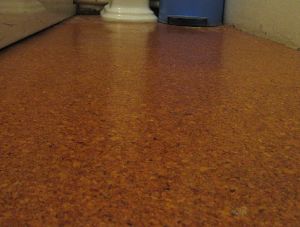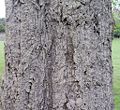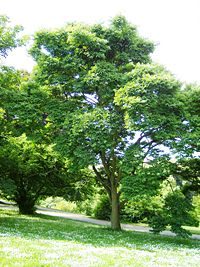Cork
term variously used for an elastic and near-impermeabile material and for two trees from which it is harvested, the cork oak and
Term also used for the unrelated... which is not a source of cork
cork cambrium biological tissue in many plants, cork cambrium cells that develops outwards are termed phellem or cork (note similarity with vascular cambium) specialized secondary tissues produced by the cork cambrium
Commercial cork is derived from the bark of the cork oak (Quercus suber). Cork has many uses including wine bottle stoppers, bulletin boards, coasters, hot pads to protect tables from hot pans, insulation, sealing for lids, flooring, gaskets for engines, fishing bobbers, handles for fishing rods and tennis rackets, etc.
Cork material
Cork material is a subset of generic cork tissue, harvested for commercial use primarily from the Cork Oak tree, Quercus suber, with Portugal producing 50% of cork worldwide.[1] Cork consists mostly of suberin. Cork's elasticity combined with its near-impermeability makes it suitable as a material for bottle stoppers, especially for wine bottles. Cork stoppers represent about 60% of all cork based production. Cork's low density makes it a suitable material for fishing floats and buoys, as well as handles for fishing rods (as an alternative to neoprene). Cork is used in musical instruments, particularly woodwind instruments, where it is used to fasten together segments of the instrument, making the seams airtight. Sheets of cork, often the by-product of more lucrative stopper production, are used to make floor tiles and bulletin boards. Granules of cork can also be mixed into concrete. The composites made by mixing cork granules and cement have low thermal conductivity, low density and good energy absorption. Some of the property ranges of the composites are density (400–1500 kg/m³), compressive strength (1–26 MPa) and flexural strength (0.5–4.0 MPa).[2]
Cork oak
| Cork Oak | ||||||||||||||||
|---|---|---|---|---|---|---|---|---|---|---|---|---|---|---|---|---|
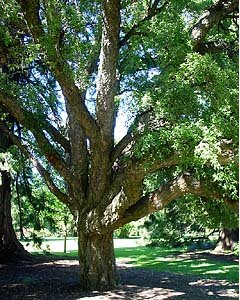 Cork Oak in Christchurch botanic gardens
| ||||||||||||||||
|
Secure
| ||||||||||||||||
| Scientific classification | ||||||||||||||||
| ||||||||||||||||
| Quercus suber L. |
The Cork Oak (Quercus suber) is a medium-sized, evergreen oak tree in the section Quercus sect. Cerris. It is native to southwest Europe and northwest Africa.
It grows to up to 20 m, although it is typically more stunted in its native environment. The leaves are 4-7 cm long, weakly lobed or coarsely toothed, dark green above, paler beneath, with the leaf margins often downcurved. The acorns are 2-3 cm long, in a deep cup fringed with elongated scales.
The tree forms a thick, rugged and corky bark. Over time this bark can develop considerable thickness and this can be harvested every 10-12 years as cork. The harvesting of cork does not harm the tree and a new layer of cork regrows, making it a renewable resource. The tree is widely cultivated in Spain, Portugal, Algeria, Morocco, France, Italy and Tunisia. Cork Oak forests cover approximately 2.5 million hectares in those countries. Portugal accounts for 50% of the world cork harvest. Cork Oaks cannot legally be cut down in Portugal, except for forest management felling of old, unproductive trees.
Cork Oaks live about 150-250 years. Virgin cork (or 'male' cork) is the first cork cut from generally 25-year-old trees. Another 10-12 years is required for the second harvest, and a tree can be harvested a dozen times in its lifetime. Cork harvesting is done entirely without machinery.
The European cork industry produces 340,000 tonnes of cork a year, with a value of €1.5 billion and employing 30,000 people. Wine corks represent 15% of cork usage by weight but 66% of revenues.
Cork Oaks are sometimes planted as individual trees, providing a minor income to their owners. The tree is also sometimes cultivated for ornament. Hybrids with Turkey Oak (Quercus cerris) are regular, both in the wild in southwest Europe and in cultivation; the hybrid is known as Lucombe Oak Quercus × hispanica.
Some cork is also produced in eastern Asia from the related Chinese Cork Oak (Quercus variabilis).
Gallery
- Cork oak.JPG
Close-up at the margin of the harvest (Massif des Maures, France).
Chinese cork oak
| Chinese Cork Oak | ||||||||||||||||
|---|---|---|---|---|---|---|---|---|---|---|---|---|---|---|---|---|
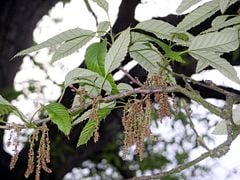 Foliage and flowers
| ||||||||||||||||
| Scientific classification | ||||||||||||||||
| ||||||||||||||||
| Quercus variabilis Bl. |
Chinese Cork Oak (Quercus variabilis) is a species of oak in the section Quercus sect. Cerris, native to a wide area of eastern Asia in China, Japan, and Korea.
It is a medium-sized to large deciduous tree growing to 25-30 m tall with a rather open crown, and thick corky bark with deep fissures and marked by sinuous ridges. The leaves are simple, acuminate, variable in size, 8-20 cm long and 2-8 cm broad, with a serrated margin with each vein ending in a distinctive fine hair-like tooth; they are green above and silvery below with dense short pubescence.
The flowers are wind-pollinated catkins produced in mid spring, maturing about 18 months after pollination; the fruit is a globose acorn, 1.5-2 cm diameter, two-thirds enclosed in the acorn cup, which is densely covered in soft 4-8 mm long 'mossy' bristles.
It is cultivated in China to a small extent for cork production, though its yield is lower than that of the related Cork Oak. It is also occasionally grown as an ornamental tree.
Phellodendron
| Phellodendron | ||||||||||||
|---|---|---|---|---|---|---|---|---|---|---|---|---|
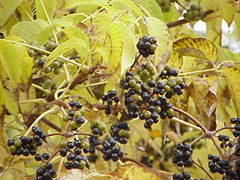 Phellodendron amurense autumn leaves and fruit
| ||||||||||||
| Scientific classification | ||||||||||||
| ||||||||||||
|
About 10 species, including: |
Phellodendron or Cork-tree, is a genus of deciduous trees in the family Rutaceae, native to east and northeast Asia. It has leathery, pinnate leaves and yellow, clumped flowers. The name refers to the thick and corky bark of some (but not all) species in the genus.
As an ornamental plant, Phellodendron is a tree for all seasons. In spring it has yellow flowers, in summer it provides foliage and shade, in fall the leaves turn bright yellow and the textured bark and winding branches add interest in the winter. The female bears black drupes that attract birds and other wildlife through the late fall and winter.
The Cork-tree is resistant to drought and insects, and it can thrive in a variety of soils. It is hardy to zone 4 and it is easy to maintain, sometimes to the point of being invasive. One drawback is that the drupes fall and scatter, which may be undesirable on a formal lawn.
The bark in some species is thick, resembling that of the Cork Oak, but is not thick enough for commercial cork production. It has been used to produce a yellow dye.
One species, Amur cork tree, Phellodendron amurense (Chinese: 黄柏; pinyin: huáng bǎi; Russian: Бархат амурский "Barkhat Amurskiy", also бархатное дерево, пробковое дерево), is one of the 50 fundamental herbs used in traditional Chinese medicine. Recently, Phellodendron has also attracted the attention of the pharmaceutical community because of the phytochemicals it produces. Berberine has antibacterial and anti-fungal properties. Jactorrhizine may be anti-mutagenic. Phellodendrine has promise as an immune suppressant. Palmatine may be a vasodilator. The phytochemical descriptions are included for informational purposes only and not for treatment purposes. The research at this stage is very preliminary. Traditionally, the bark is the principal part of the plant used medicinally, although oil from the fruit is also used. The species grows in Northern China, and in the Khabarovsk and Primorskiy regions of Russia.
Already identified as a significant forest invader in the mid-Atlantic region, Phellodendron amurense is an emerging species of concern in New England, and is identified as invasive or having invasive tendencies by state and private conservation authorities.[1] [2] [3] Because the fruit is plentiful and high in sugars, Amur cork-tree attracts birds and mammals which help disperse its seeds. Because of its phytochemical profile and because the seedlings grow thickly, Phellodendron can out-compete other species. By suppressing reproduction of native hardwoods, Amur cork-tree can come to dominate native forests under favorable conditions. As a relatively new species of concern, its invasion biology and response to control is not well understood.
Cork cambium
Cork cambium is a tissue found in many vascular plants as part of the periderm. The cork cambium is a lateral meristem and is responsible for secondary growth that replaces the epidermis in roots and stems. It is found in woody and many herbaceous dicots, gymnosperms and some monocots, which usually lack secondary growth.
Cork cambium is one of the plant's meristems - the series of tissues consisting of embryonic (incompletely differentiated) cells from which the plant grows. It is one of the many layers of bark, between the cork and primary phloem. The function of cork cambium is to produce the cork, a tough protective material.
Synonyms for cork cambium are bark cambium, pericambium or phellogen. Phellogen is defined as the meristematic cell layer responsible for the development of the periderm. Cells that grow inwards from the phellogen are termed phelloderm, and cells that develops outwards are termed phellem or cork (note similarity with vascular cambium). The periderm thus consist of three different layers;
- phelloderm,
- phellogen (cork cambium) and
- phellem.
Growth and development of cork cambium is very variable between different species, and also highly dependent on age, growth conditions etc. as can be observed from the different surfaces of bark; smooth, fissured, tesselated, scaly, flaking off, etc.
ReferencesISBN links support NWE through referral fees
- Junikka, L. (1994) Macroscopic bark terminology. IAWA Journal 15(1): 3-45
- Trockenbrodt, M. (1990) Survey and discussion of the terminology used in bark anatomy. IAWA Bulletin, New Series 11: 141-166.
External links
- APCOR – Associação Portuguesa de Cortiça (Portuguese Cork Association)
- Photograph of cork oaks in Portugal
Credits
New World Encyclopedia writers and editors rewrote and completed the Wikipedia article in accordance with New World Encyclopedia standards. This article abides by terms of the Creative Commons CC-by-sa 3.0 License (CC-by-sa), which may be used and disseminated with proper attribution. Credit is due under the terms of this license that can reference both the New World Encyclopedia contributors and the selfless volunteer contributors of the Wikimedia Foundation. To cite this article click here for a list of acceptable citing formats.The history of earlier contributions by wikipedians is accessible to researchers here:
- Cork_Oak history
- Chinese_Cork_Oak history
- Phellodendron history
- Cork_(material) history
- Cork_cambium history
The history of this article since it was imported to New World Encyclopedia:
Note: Some restrictions may apply to use of individual images which are separately licensed.
- ↑ pressedforwine.com Corks for Wine Bottles
- ↑ Karade SR. 2003. An Investigation of Cork Cement Composites. PhD Thesis. BCUC. Brunel University, UK.

